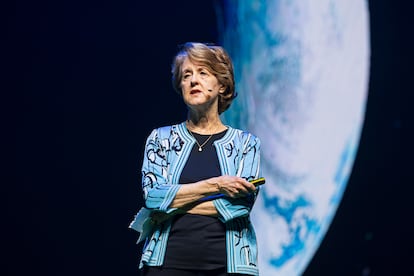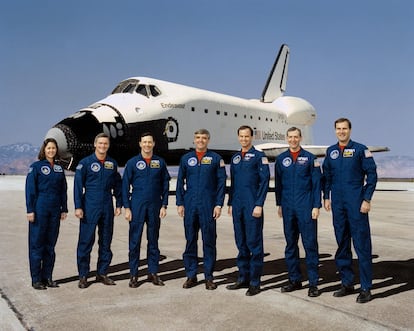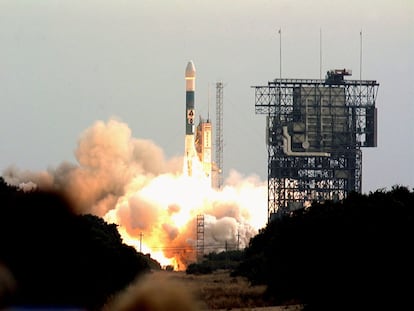NASA astronaut Kathryn Thornton: ‘All the progress we’ve made over the past 70 years is in peril’
The physicist, one of the women who has spent the most time outside a spacecraft, discusses NASA, new technology, and what it feels like to walk in space

Alabama-born physicist Kathryn Thornton, 72, embodies a historic shift in space exploration. Born into a working-class family, her first job was washing dishes in the restaurant run by her parents, who wanted their children to be the first in their family to go to college. Thornton not only achieved that, but also became one of the first female astronauts, embodying the new face of space exploration at NASA, which until then was dominated by white men with military training.
Thornton traveled to space four times between 1989 and 1995, and is the woman who has spent the second-longest time outside a spacecraft, performing spacewalks. In 1993, she was the only woman to participate in one of the most complicated spacewalks in history to repair the Hubble Space Telescope, an observatory that had cost around $2 billion and was returning blurry images due to a flaw in its optics. The mission was successful and restored the instrument for science, which has since helped make some of the greatest discoveries in the history of astronomy. Many years later, Thornton’s eldest daughter, who was 11 years old when her mother helped repair Hubble, earned a PhD in astrophysics using images taken by the very same telescope.
This week, Thornton will visit Spain to give a talk at the Starmus Festival, which kicks off Friday on the Canary Island of La Palma. In this interview with EL PAÍS, the astronaut reflects on how much space exploration has changed, especially in the current era, which she views with some dismay. She expresses astonishment at Elon Musk’s power and his influence over NASA, as well as concern about Donald Trump’s attacks on science in the U.S.
Question. How would you explain to someone what it would feel like to go into space for a spacewalk?
Answer. You train in the water tank and other simulators, but you find out when you first go out that all simulators lie to you in one way or another. And so you get pretty smart in the first 20 minutes about how to move around and maintain control of your body. Because when there’s no gravity, and you stop moving your hands, for example, the rest of your body still has momentum unless you apply an opposite torque to keep your rear end behind your front end. I’d say it’s like moving a refrigerator on ice, while wearing skates. It’s hard to get moving, but much harder to stop.

Q. What is your most vivid memory from your trips to space?
A. One of them was definitely letting go of the solar array from the Hubble we repaired. I just took my hands off of it, didn’t push it anywhere, and it floated away. I could see it flapping like a giant bird flying through space, right above Saudi Arabia, which is a beautiful part of Earth seen from space. It was mesmerizing.
Q. Do you have any bad memories from traveling to space?
A. On my second mission, I had a rather frustrating experience. We had to capture a satellite and strap a new booster motor on it. But it turned out to be much more difficult than expected. The predictions about how it would behave when interacted with were pretty far off. It weighed about 4,000 kilograms, and half of that mass was liquid propellant. And the satellite was rotating, which gave it gyroscopic stability, but since it wasn’t a solid mass, it didn’t behave exactly like we thought. The method we had intended to capture it with didn’t work. So we did the first and only three-person spacewalk. I was inside, guiding everything and making sure they got into the airlock. They went out and grabbed it with their hands.
Q. You were one of the first female astronauts, and you were at NASA for 12 years, what was that experience like?
A. I wouldn’t say it was terribly challenging. The fit of some things, particularly the spacesuit, was probably the biggest challenge because it wasn’t custom-made. It’s made up of various parts. So they give you a shorter upper arm than some of the guys would wear, a shorter lower arm, but they don’t change the diameter. When you try to bend your elbow, you start interfering this piece with this piece, which restricts your movement enormously. When you’re training in the water, you’re flopping around inside that suit. If I were to get positioned on my back in the tank, I would fall into the back of the suit and I couldn’t reach the gloves because my arms couldn’t reach. There were a lot of things like that. It’s not really a gender thing; it’s more a build thing, which of course is correlated with gender. In the end, you can either complain and make someone else do it, or work really hard to make it work. And that’s what I did.

Q. What do you think about current space exploration?
A. There have been many changes. My NASA was completely different to that of the Mercury, Gemini, and Apollo programs. At the NASA I came into in the shuttle program, we were flying a lot of people, and we were flying a lot. I myself had four flights in six years, which is unheard of now. With the retirement of the shuttle and the arrival of the space station, everything changed. I don’t think we’ll ever see that rate or that number of flights again. Crewed missions to recover satellites or repair Hubble are no longer possible. I don’t know that that’s a bad thing if we go off and do something even more spectacular. I would love to see people walk on Mars, but I don’t think it’s going to happen.
Q. Do you support going to Mars instead of the Moon?
A. Yes, I’m on the Mars side. If we need to go to the Moon sooner to make the journey safer, then I support that too. But I worry that if we establish a permanent base on the Moon, that we will have sunk an anchor in there and have a hard time moving past that.
Q. Why?
A. After the end of the Apollo program in the 1970s, our next goal was to have a permanent presence in space: a space station. That was the focus for over 25 years, until we finally achieved it in 2000. Since then, there’s always been somebody in space. But we haven’t done much else: just orbited the Earth over and over again. We won’t be able to move forward until we end that. We have to decommission the space station, and NASA will hand over the baton to commercial space stations. Only then can NASA move on to the Moon and, hopefully, develop something beyond.
Q. Did you ever imagine that the richest man in the world would be a space entrepreneur sitting to the right of the president of the United States?
A. I’m completely flummoxed by that whole concept. Every day we’re surprised by something new, and we have no idea what’s going to happen next. Unfortunately, I have no factual information. I can only blather my thoughts, which aren’t necessarily based in fact, but rather on what I read or hear.
Q. Are you concerned about a wave of layoffs and cancellation of projects like the new Nancy Roman Space Telescope?
A. Yes, some of the science missions are probably in danger. It’s heartbreaking. Not just for NASA, but for the other space agencies.
Q. Could the mission to land the first woman and person of color on the moon also be in jeopardy?
A. Yes, of course. All the progress we’ve made over the past 70 years is in peril.
Q. What do you think of China as a new space power?
A. China is already our biggest competitor. Before that, it was the Soviet Union, and that competition is what got us to the Moon. I don’t see competition as a bad thing. In the past, even with ballistic missiles pointed at each other, we collaborated with the Soviets in space. We’ve worked with the Russians for 25 years on the space station. I think we could do that with China, if we chose to. But right now, we’re in a competition.
Q. What current space technology do you find most promising?
A. There’s a lot of potential in high-specific-impulse, low-thrust engines, like plasma engines. When I was teaching orbital mechanics, I asked my students to design a trajectory to Mars, and they unwittingly proposed an idea very similar to the Gateway [the lunar outpost]: take multiple components out of Earth’s gravity, assemble them in space, and, at least for cargo, use low-thrust, continuously operating thrusters — like a “slow boat” like the ones that go to Antarctica. You can send cargo to the Gateway, and from there, slowly to Mars. For people, we would use a different system, but for materials, it’s a possibility.
Sign up for our weekly newsletter to get more English-language news coverage from EL PAÍS USA Edition
Tu suscripción se está usando en otro dispositivo
¿Quieres añadir otro usuario a tu suscripción?
Si continúas leyendo en este dispositivo, no se podrá leer en el otro.
FlechaTu suscripción se está usando en otro dispositivo y solo puedes acceder a EL PAÍS desde un dispositivo a la vez.
Si quieres compartir tu cuenta, cambia tu suscripción a la modalidad Premium, así podrás añadir otro usuario. Cada uno accederá con su propia cuenta de email, lo que os permitirá personalizar vuestra experiencia en EL PAÍS.
¿Tienes una suscripción de empresa? Accede aquí para contratar más cuentas.
En el caso de no saber quién está usando tu cuenta, te recomendamos cambiar tu contraseña aquí.
Si decides continuar compartiendo tu cuenta, este mensaje se mostrará en tu dispositivo y en el de la otra persona que está usando tu cuenta de forma indefinida, afectando a tu experiencia de lectura. Puedes consultar aquí los términos y condiciones de la suscripción digital.
More information
Archived In
Últimas noticias
‘How does it feel to be a failure?’: Elizabeth Berkley’s journey from ‘Showgirls’ ridicule to vindication
The story of the Málaga virus: The code that haunted Google’s cybersecurity center director for 30 years
The impact of Ecuador’s mega-prison: A polluted river, cleared forests and military checkpoints
Corinne Low: ‘I’m more concerned about the female happiness gap than the gender wage gap’
Most viewed
- The low-cost creative revolution: How technology is making art accessible to everyone
- Christian Louboutin: ‘Young people don’t want to be like their parents. And if their parents wear sneakers, they’re going to look for something else’
- All the effects of gentrification in one corner of Mexico’s Colonia Roma
- Liset Menéndez de la Prida, neuroscientist: ‘It’s not normal to constantly seek pleasure; it’s important to be bored, to be calm’
- Christmas loses its festive spirit: ICE fears cast shadow over religious celebrations











































